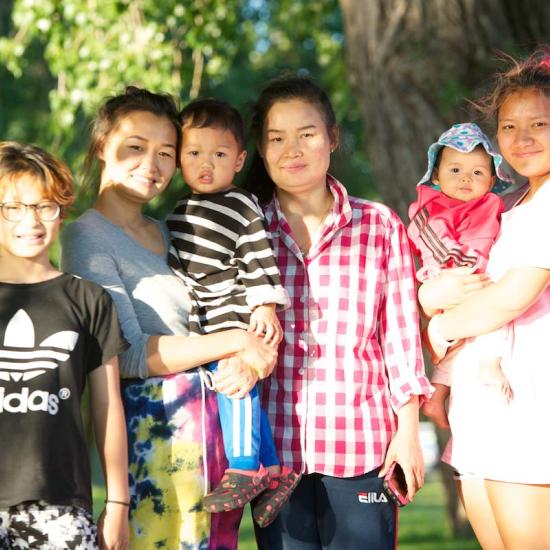
Our community needs mental health and substance use disorder services more than ever
Wilder’s goal is to help children, adults and their families grow and heal with our mental health and wellness services. Together with participants, partners and the community, we are focused on making trauma-informed and culturally centered services accessible for Minnesotans.
Each year, more than 2,000 children, adults and their families are supported with mental health and wellness services at Wilder. Our community has access to outpatient services that range from low to high intensity. Therapists, nurses, alcohol and drug counselors, psychologists, psychiatrists, care coordinators, peer specialists and case managers work closely with clients to support their mental wellness.
Our work is both trauma- and culturally informed. We see people where it works for them, whether it’s in the clinic, school, library, and sometimes our cars, in the community and in their homes. Our services are tied to what works for people and communities.
The pandemic transformed access to services with telehealth
During the early days of the pandemic, Wilder’s therapists, caseworkers and other mental health professionals supported participants by phone, tablet and computer. Members of a newly formed telehealth team researched platforms, asked participants for feedback and, when needed, traveled to participants’ homes to deliver devices and make sure participants were comfortable using them.
As the months passed by, mental health services returned to in-person services at times and in ways that made sense for participants. Day Treatment, the most intensive children’s mental health service offered through Wilder, returned to in-person services in October 2020, for example. Outpatient mental health services, commonly known as therapy appointments, are now available both in-person and by video.
Even when most services were handled remotely, Wilder continued to find new ways to make services accessible.
Telehealth is only one part of Wilder’s work to increase access to mental health services. Over the last two years, Wilder has continued to explore new ways to make sure people can get the help they need.
Virtual and in-person walk-ins
Adults of all ages and teens 12-17 can walk into our clinic (in-person or virtually) to receive a mental health or substance use disorder evaluation and diagnosis, help with services and qualifications, and coordinate options for care and appointments.
Cultural brokers
Staff who speak the languages and know the cultures of our community and are trained to help families and providers navigate treatment and systems.
Aging and mental health support group
Adults age 60 and older can now attend a free monthly online group designed to reduce barriers and overcome stigma attached to mental health services.
Expanded school-based mental health services
Students have access to therapy in 30 schools, a number that is growing with support from the Wilder Campaign for Families. School-based mental health services make it easier for children to get the help they need to succeed at home and in school.
Research to shape behavioral telehealth services statewide
Wilder Research is working with the Minnesota Department of Human Services to evaluate how the telehealth format impacts access to and quality of services. Involving service participants is key to the process: An expert panel of Medicaid enrollees is helping guide the work, providing input and sharing their experiences to inform future policies.
What Can Access to Mental Health Services Look Like?
Mark walked into our clinic. He left with support and a safety plan.
It had been a busy Tuesday in our Community Mental Health & Wellness Clinic. We had several walk-in clients in addition to scheduled clients. By 5:00 p.m., staff were ready to call it a day and go home. But there was one more walk-in.
“Mark” had been seen for evaluation by one of our therapists a few weeks ago. Mark is homeless and lives with schizophrenia. Today, he reported that his ID card and wallet were recently stolen and believed his phone and laptop were bugged. He was confused and worried and asked if there was anyone he could talk to.
The front desk staff listened to his concerns and worked quickly to find a therapist to meet with him. The therapist stopped packing to go home, validated Mark’s worries and supported him in safety planning for the night. At the end of the meeting, Mark said it helped to talk to her; he wants help but people (family members, the police, staff at shelters) usually brush him off. He was agreeable to setting up a time to come back again and seemed less anxious and confused.
The therapist who had done his evaluation reminded Mark that they’d met before and wrote down the days and times he was at the clinic as well as the clinic’s walk-in hours. Mark remembered the therapist and seemed reassured by his presence.
Mark came in confused, worried, and lonely. He left feeling supported and equipped with a return appointment, resources, food, and winter gear.
—Gael Thompson, Clinical Manager
Related Stories and Insights
Stories
- Then and now, Wilder school-based mental health services helped Sean grow and succeed
- Wilder Mental Health Forges New Ways of Connecting with Telehealth
Blog posts
- Building a Stronger, More Diverse Mental Health Workforce
- Therapy by Video: What Works in Telehealth?
- Why Hmong Families Need Hmong School-Based Mental Health Providers
Podcasts